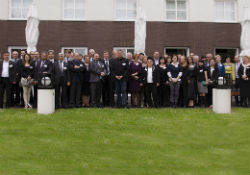WHO environment and health meeting on the economic costs of asbestos

WHO
On 18 and 19 May 2016, Bonn, Germany hosted the WHO international meeting on the economic health costs and impacts that the past and present use of asbestos has on society. Participants were representatives of 13 countries – Armenia, Azerbaijan, Belarus, Bosnia and Herzegovina, Georgia, Kazakhstan, Kyrgyzstan, the Russian Federation, Serbia, Tajikistan, the former Yugoslav Republic of Macedonia, Turkmenistan and Ukraine – and experts from international organizations and research institutes.
This meeting contributed, in particular, to one of the commitments of the Parma Declaration on Environment and Health to develop national programmes to eliminate asbestos-related diseases (ARDs) by 2015. ARDs are responsible for an estimated 107 000 deaths per year worldwide.
Different country asbestos profiles were presented at the meeting. Participants also discussed the rising medical costs associated with ARDs, the rising prevalence in mesothelioma- and asbestos-associated lung cancer, the economic effects of their imposed asbestos bans and the use of alternatives.
A new global report on the effects on gross domestic product, employment and health costs in countries that banned asbestos use in the 1980s was presented. The report found no observable effects on national or regional economies, except for a short drop in local employment in regions that were former large asbestos producers. Health costs for dealing with ARDs, however, far outweigh the benefits, with annual direct health care costs estimated at 2–3 billion US dollars. Also, high costs are associated with removal and replacement of asbestos and litigation.
In addition to the economic analyses, WHO presented a stakeholder analysis, identifying the key stakeholders related to not only the use of all forms of asbestos but also its consequences. In this analysis, different stakeholders were asked to identify barriers for banning the use of asbestos and solutions to the problem. Workshop discussions with all participants helped identify the most important actions needed. The economic analyses of all aspects of the use of asbestos (its mining, use, removal and the disease it may cause) stressed the need to give it the proper priority in the political agenda.
WHO acknowledges the financial support from the German Federal Ministry for the Environment, Nature Conservation, Building and Nuclear Safety towards the funding of this meeting.
About asbestos
Asbestos is a naturally occurring fibrous mineral, mined as a low-cost and long-lasting construction material, well known for its heat-resistance properties and used in many products. But, all forms of asbestos are classified by the International Agency for Research on Cancer as human carcinogens. Inhalation of asbestos fibres strongly increases the risk of developing different ARDs. All ARDs have long latency period from the exposure to the development of diseases, which can spread up to 40 years.
Because of its health impacts, many countries have already banned the use of all forms of asbestos long ago and replaced it with safer materials. In the long term, however, based on the data from the countries which used asbestos in the past, this will lead to disease development and substantial medical costs.



